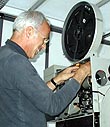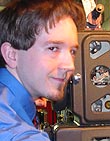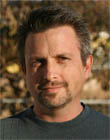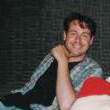|
|
This topic comprises 2 pages: 1 2
|
|
Author
|
Topic: Surround channel for drive-ins?
|
|
|
|
|
|
|
|
|
|
|
|
|
|
|
Frank Angel
Film God

Posts: 5305
From: Brooklyn NY USA
Registered: Dec 1999
|
 posted 06-03-2006 09:07 AM
posted 06-03-2006 09:07 AM





Dolby has a virtual surround chip that many consumer products imploy that can produce sounds that trick your ears into hearing sounds that seemingly come from behind you. It can actually produce some quite startling effects and it can easily be employed for car sound systems.
You need to take the LCRS channels and input them into a device that uses the matrix chip like the Sony Virtual Surround Headset unit. It takes the 4 channels and does the virtual surround trick on it and then outputs two VS encoded channels. Playing back the two channels will result in the surround coming from what seems like a position behind your head.
Thing is, this works best if someone is sitting directly between the two speakers in the near field. In a car, they are usually close enough for it to work pretty well, although they might not be dead center. In that case, the audio illusion will shift a bit, locating the surround channel to the left or right, but still behind the listener.
This system seems a perfect application for DIs. If nothing else, the first DI to imploy it could certainly benefit from being able to use it as a marketing tool -- The First Drive-In with Dolby Virtual Surround Sound -- Better Than The Multilpex. (yah, yah, I hear you all moaning, but since when do the marketing departments of corporate America worry about the verasity of their hype?) Anyway, no question, if I owned a DI, I certainly would insert this Dolby VS thing between my processor and the transmitter. And if I were Dolby, I'd but that $10 chip in a 1U box, market it to DIs and charge $800 for it.
Here....I found an earlier post with Sony's Virtual Surround Headset product description: MRD-DS000 Sony's Virtual Digital Surround Processor:
The processor has 6 inputs and sends the processed virtual surround two channel signal to the headsets via infrared. The unit has an output 1/4in TRS jack for a corded headset which is where you can also get the processed VS signal. That is where you would get your Lvs /Rvs signal to feed the transmitter.
Sony sez:
Enjoy the surround sound equivalent to that of 6 speakers (using only two) when you listen with Sonys MDR-DS8000 Infrared Cordless® Digital Surround Headphone System.
....this system is compatible with DTS ES, Dolby Digital EX, DTS, Dolby Digital, Dolby Surround, Dolby Pro Logic II and MPEG2 AAC. ... an Optimum surround field is created anywhere (between two speakers) -- simply select Input, Effect Mode, & Output. For a more realistic surround sound experience, choose the MDR-DS8000
This unit with the infrared headset has a list on the Sony site for $799, but I know I saw it for half that street price. Again, small price to pay to give them surround sound in the car. I know if I owned a DI, you bet I would have this thing installed in the blink of an eye and then go about getting Filmack to make me a snipe proclaiming that we had Dolby Digital Surround.
| IP: Logged
|
|
|
|
|
|
Jack Ondracek
Film God

Posts: 2348
From: Port Orchard, WA, USA
Registered: Oct 2002
|
 posted 06-03-2006 12:27 PM
posted 06-03-2006 12:27 PM





quote: Bobby Henderson
I'd love for drive-in movie theaters to become more popular. But the audio area needs to be improved.
Ahhhh.... one of my favorite subjects! ![[Smile]](smile.gif)
A drive-in is presently capable of providing audio at least as good as any off-air FM station... which may not be much of a compliment... OK... take a decent PBS station... we can do that, too.
To start with, analog FM is a total abomination to a purist at any level. Once you deal with how to cram decent audio into a system with 75ms pre-emphasis, you wind up with a technology that's maybe quieter... but not a whole lot more dynamic than an LP record.
In any case, getting decent sound in a drive-in is all a matter of money... something most owners are notoriously tight with. That alone is the single largest reason for any drive-in not to have excellent sound... or picture, for that matter. Drive-in operators have a curious sense of priority... something that may have a little to do with not getting out there all that often. I once saw a drive-in that had made the major move to FM, by feeding an old Eico bench oscillator from their Motiograph amps... with resultant audio that sounded worse than their speakers. On the other hand, there are a whole lot of indoor houses that are running mono, and they seem to be surviving.
You can buy an FM transmitter that could be used in any commercial station as a high-quality stereo exciter for less than $1,000. Past that, it's what and how you feed it.
You could get SR out to a car, if there was anything out there to decode it, but you'd probably have to pass it directly from the NR cards to the transmitter. That would create its own set of problems, since analog FM doesn't even have the dynamic range of Dolby SR... much less anything digital.
In any case, it could be said that we're pushing things a bit, just being stereo. Given the popularity of SUVs, a huge percentage of our customers BACK into their slots... thereby reversing their stereo image. Nobody's ever mentioned that one to us, which makes me wonder if we shouldn't all be using Kintek comb filters instead.
HD isn't likely to become available anytime soon to anyone but FM broadcasters with lots of $$$$ and a way to earn it back. The process is patented up the gazoo, by a single company (something like DLP?). Chances are, it won't hit the consumer or semi-pro markets anytime soon... and I doubt any drive-in is going to pay the big bucks for THAT technology.
Top notch right now? I'd guess it'd be whatever flavor of digital audio you'd care to put in, though Louis rightly observes that properly tuned SR has better figures than any analog FM system. We have Dolby and DTS at our place, with CP-65s as backups. Then, you have to mash everything down to 2 channels... doable with active mixers. Pick your own switching/routing method to suit, then it's really just a matter of how much you want to put into the FM signal itself. Broadcast Warehouse makes transmitters that would satisfy just about anyone. I recently saw some Drake modulators that appeared to work fine. Depending on how picky your ears are, you can get darn near major market (Omnia/Orban) performance out of your transmitter with a Broadcast Warehouse DSPExtra processor ($6,000), though their transmitters include a simple wideband comp/limiter... if you don't mind that.
The point is that, given a little work and money, any drive-in can put out an FM signal that can compare with any radio station available to you, except for transmitter power. Given the variabilities and limitations, imposed by virtue of the environment (the car) and how it... and its listeners are positioned within it, you could make the argument that multi-channel transmissions could not possibly be received as intended... even if you COULD get the channels out there. Comparing drive-in FM to your car CD player isn't fair, since you're dealing with totally different animals. All of the negative commentary can be applied to every other signal on the FM dial. In the end, my FM channels sound every bit as good (or bad) as the Seattle area stations you'd have available to compare them to. Transmitting from a drive-in really has nothing to do with it.
I do agree with your observations about light levels though. Hopefully, that's a detail that will get more attention by the designers.
| IP: Logged
|
|
|
|
|
|
|
|
Frank Angel
Film God

Posts: 5305
From: Brooklyn NY USA
Registered: Dec 1999
|
 posted 08-06-2006 08:36 AM
posted 08-06-2006 08:36 AM





Remixing all channels back into the Left and Right input to the FM transmission shouldn't cause any phase problems....in theory. However, depending how some surround effects are actually created by the sound engineer, sometimes using time delay and phase manipulation to create a more open and spacial spread to the sound and then it's mixed into the descrete surround channels. This kind of manipulation will not necessarily cause any trouble since descrete channels are never electrically mixed. They are only mixed acoustically once they are reproduced in the theatre. However, if the heavily processed rear channels audio is mixed back into the left and right front channels, this could cause a very unpleasant flanging effect.
Do you monitor the audio from an FM receiver? That would pretty much be what they hear in their cars. Or at least to you tap the signals at the input to the transmitter would give you a good idea of what your mix is sounding like? If there is any distortion caused by remixing, you would hear it there.
As for the subwoofer channel, I would wonder if there is any advantage remixing that subbass channel back into your L/R remix since wouldn't this be putting out audio that is below what the FM transmitter can reproduce? Would it unneccessarily muddy up the overall audio? Or a better question would be, do it actually add anything that can be reproduced by the FM transmitter?
I would also wonder if the digital tracks (SRD, DTS or SDDS)don't present more problems that have to be worked around to make the audio acceptable for FM broadcast. Specifically I am thinking about the greater dymanic range of digital signals that is much wider than FM transmitter is capable of modulating. Wouldn't you wind up having to heavily limit the input to the transmitter to prevent overdriving it?
I would think that the SR Lt & Rt analog tracks would more closely match to the limitations of FM transmission in terms of dynamic range and frequency response as well as not needing any remixing -- SR's Lt & Rt channels simply feed into 2 FM transmission channels, whereas all of the advantages of digital -- the 6 channels, the dynamic range, the higher frequency response -- are really not advantages for FM: the higher frequency response will not be reproduced by the FM transmission, the greater dynamic range will have to be severely reigned in so as not to overdrive the transmitter and all those channels will need to be remixed back down to 2.
I guess the ability to be able to run the Dolby or DTS digital trailer may be the biggest advantage of using digital as the playback system for an FM transmission system, although you have heard both on the same system -- I would be curious to hear your take on it.
As for the peeps who turn their vehicles around....hey, you are sending the left and right correctly, you can't be responsible if the patrons do stuff that screws that up, just like if people in my theatre want to sit facing the rear wall, hey....not my fault. ![[Wink]](wink.gif)
| IP: Logged
|
|
|
|
All times are Central (GMT -6:00)
|
This topic comprises 2 pages: 1 2
|
Powered by Infopop Corporation
UBB.classicTM
6.3.1.2
The Film-Tech Forums are designed for various members related to the cinema industry to express their opinions, viewpoints and testimonials on various products, services and events based upon speculation, personal knowledge and factual information through use, therefore all views represented here allow no liability upon the publishers of this web site and the owners of said views assume no liability for any ill will resulting from these postings. The posts made here are for educational as well as entertainment purposes and as such anyone viewing this portion of the website must accept these views as statements of the author of that opinion
and agrees to release the authors from any and all liability.
|

 Home
Home
 Products
Products
 Store
Store
 Forum
Forum
 Warehouse
Warehouse
 Contact Us
Contact Us




 Printer-friendly view of this topic
Printer-friendly view of this topic










![[Razz]](tongue.gif)

![[thumbsup]](graemlins/thumbsup.gif)



![[Roll Eyes]](rolleyes.gif)
![[Smile]](smile.gif)

![[Cool]](cool.gif)
![[beer]](graemlins/beer.gif) , I guess.
, I guess.![[Wink]](wink.gif)



